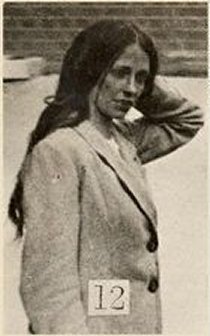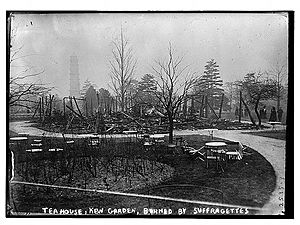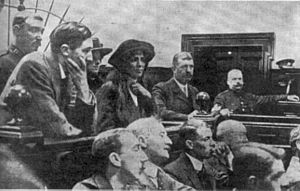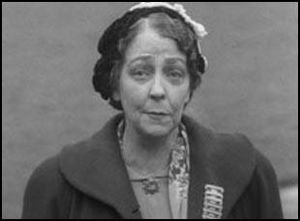Lilian Lenton facts for kids
Quick facts for kids
Lilian Lenton
|
|
|---|---|

Lilian Lenton in a Home Office surveillance photograph of c.1912
|
|
| Born | 5 January 1891 Leicester, England
|
| Died | 28 October 1972 (aged 84) |
| Nationality | British |
| Occupation | Suffragette |
Lilian ("Lillie") Ida Lenton (born January 5, 1891 – died October 28, 1972) was an English dancer and a brave suffragette. Suffragettes were women who fought hard to get the right to vote. Lilian also won a medal from the French Red Cross for her work as an orderly during World War I.
Early Life and Becoming a Suffragette
Lillie Lenton was born in Leicester, England, in 1891. She was the oldest of five children. After finishing school, she trained to be a dancer.
One day, she heard Emmeline Pankhurst speak. Emmeline was a very important leader of the suffragette movement. Lillie was so inspired that she decided to join the fight for women's voting rights as soon as she turned 21.
When she reached that age, Lillie joined the Women's Social and Political Union (WSPU). This group was known for its strong actions to get attention for their cause. In March 1912, Lillie and other members took part in a campaign where they broke windows. She was arrested and spent two months in jail, using the name "Ida Inkley" to hide her identity.
Fighting for the Vote

In early 1913, Lillie Lenton and another suffragette named Olive Wharry started setting fires to buildings in London as a protest. They were arrested in February 1913 because they were suspected of setting fire to the Tea House at Kew Gardens.
While in Holloway Prison, Lillie went on a hunger strike. This meant she refused to eat. After two days, she was forcibly fed. This was a very painful and dangerous process where food was pushed into her body. It made her very sick with a lung infection called pleurisy. Because she was so ill, she was quickly and quietly released from prison.
Her case caused a lot of public anger. To avoid more problems like this, the government quickly created a new law in April 1913. It was called the "Cat and Mouse Act". This law allowed hunger-striking suffragettes (the "mice") to be released from prison when they became too sick. But once they recovered, the police could arrest them again (the "cat").
Lillie was arrested again in June 1913 in Doncaster. She was charged with being at a house that had been set on fire. She was released from Armley Prison in Leeds after a few days, and this time, no one tried to force-feed her.
In July 1913, the police were looking for Lillie in Leeds. But she managed a very clever escape! She swapped places with another suffragette and hid in a delivery van. She then traveled to Harrogate and Scarborough, and from there, she escaped to France on a private yacht.
Lillie later explained why she took such strong actions. She said her goal was to set fire to two buildings a week when she was out of prison. She wanted to create a situation where the country became impossible to govern. This was to show that the government could not rule without the agreement of the people it governed, especially women.
She was arrested again in October 1913 at London Paddington station. While waiting for her trial, she went on another hunger and thirst strike. She was force-fed again, which made her very ill. She was released for a few days to recover but escaped once more.
Lillie was arrested again in December 1913 for setting fire to a house in Cheltenham. She was recognized from a police photo. In prison, she started another hunger and thirst strike and was released again. She escaped from care and remained free until May 1914, when she was arrested in Birkenhead. She went on hunger and thirst strike again and was released on May 12, 1914.
Because she escaped so often, Lillie became known as the "tiny, wily, elusive Pimpernel". She received a special Hunger Strike Medal "for Valour" (meaning bravery) from the WSPU.
The Women's Social and Political Union stopped their strong protests in 1914 when World War I began. They decided to focus on helping with the war effort instead. During the war, women took on many jobs that men usually did. This showed everyone that women could do these jobs just as well. This helped to convince people that women deserved the right to vote.
After the war, in 1918, a law was passed that gave some women the right to vote. These were women over 30 who owned a house or were married to someone who did. Lillie Lenton was not very impressed by this law because it didn't include all women. She later said she didn't vote for a long time because she didn't have a husband or furniture, even though she was over 30. All women were finally given equal voting rights to men in 1928, when Lillie was 37.
Later Life and Legacy
Just before World War I, Lillie Lenton met the famous author D.H. Lawrence when she was escaping from the police in the Lake District. During World War I, Lillie worked in Serbia with the Scottish Women's Hospitals for Foreign Service. She was given a French Red Cross medal for her service.
After the Russian Revolution, she traveled in Russia with another suffragette named Nina Boyle. Lillie later worked at the British Embassy in Stockholm. She also became a speaker for the Save the Children Fund. From 1924 to 1933, she was a speaker and travel organizer for the Women's Freedom League. She also edited the League's Bulletin for over 11 years. After working in Scotland to help animals, Lillie became the financial secretary of the National Union of Women Teachers until 1953.
In 1955, Lillie appeared on a BBC News broadcast with other former suffragettes. They were beside the statue of Emmeline Pankhurst to celebrate 37 years since women got the vote. She was filmed again in 1959, talking about the "Cat and Mouse Act." She was also interviewed in October 1961, where she talked about meeting D.H. Lawrence.
In 1970, Lillie Lenton helped to unveil a memorial in Christchurch Gardens, Westminster. This memorial was dedicated to all the women who had fought to get the right to vote.
Lilian Lenton passed away in 1972. She never married.



